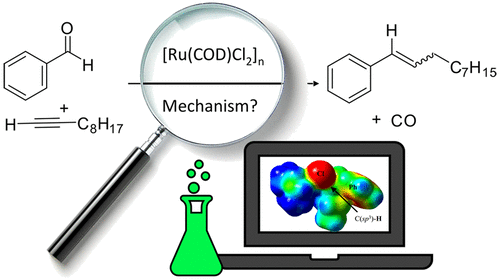Our official English website, www.x-mol.net, welcomes your feedback! (Note: you will need to create a separate account there.)
Revised Mechanism for a Ruthenium-Catalyzed Coupling of Aldehyde and Terminal Alkyne
ACS Omega ( IF 4.1 ) Pub Date : 2018-03-16 00:00:00 , DOI: 10.1021/acsomega.7b01877 Anna Tomberg 1 , Soumen Kundu 1 , Feng Zhou 1 , Chao-Jun Li 1 , Nicolas Moitessier 1
ACS Omega ( IF 4.1 ) Pub Date : 2018-03-16 00:00:00 , DOI: 10.1021/acsomega.7b01877 Anna Tomberg 1 , Soumen Kundu 1 , Feng Zhou 1 , Chao-Jun Li 1 , Nicolas Moitessier 1
Affiliation

|
Ruthenium catalysts have been found to be of great use for many kinds of reactions. Understanding the details of the catalytic cycle allows to not only rationalize experimental results but also to improve upon reactions. Herein, we present a detailed computational study of a ruthenium-catalyzed coupling between a terminal alkyne and an aldehyde. The reaction under examination facilitates novel access to olefins with the concurrent loss of a single carbon as carbon monoxide. The reaction was first developed in 2009, but the tentative mechanism initially proposed was proven to be contradictory to some experimental data obtained since then. Using a combination of computational investigations and isotope-labeling experiments, several potential mechanisms have been studied. In contrast to the [2+2] cycloaddition mechanism suggested for similar catalysts, we propose a new consensus pathway that proceeds through the formation of a ruthenium–vinylidene complex that undergoes an aldol-type reaction with the aldehyde to yield the product olefins. Computational insights into the influence of different reagents used to optimize reaction conditions and the intricacies of decarbonylation of a Ru–CO complex affecting catalyst turnover are highlighted.
中文翻译:

钌催化的醛和末端炔的偶联机理的修订
已经发现钌催化剂在许多种反应中都有很大的用途。了解催化循环的细节不仅可以使实验结果合理化,而且可以改善反应。在这里,我们提出了在末端炔烃和醛之间钌催化偶联的详细计算研究。所检查的反应有利于新颖地获得烯烃,同时损失了一个碳,即一氧化碳。该反应最早于2009年开发,但最初提出的试验机制被证明与此后获得的一些实验数据相矛盾。结合计算研究和同位素标记实验,已经研究了几种潜在的机制。与类似催化剂所建议的[2 + 2]环加成机理相反,我们提出了一条新的共有途径,即形成钌-亚乙烯基络合物,该络合物与醛进行醛醇缩合反应,生成产物烯烃。强调了对用于优化反应条件的不同试剂的影响以及Ru-CO络合物的脱羰作用影响催化剂转化率的复杂性的计算见解。
更新日期:2018-03-16
中文翻译:

钌催化的醛和末端炔的偶联机理的修订
已经发现钌催化剂在许多种反应中都有很大的用途。了解催化循环的细节不仅可以使实验结果合理化,而且可以改善反应。在这里,我们提出了在末端炔烃和醛之间钌催化偶联的详细计算研究。所检查的反应有利于新颖地获得烯烃,同时损失了一个碳,即一氧化碳。该反应最早于2009年开发,但最初提出的试验机制被证明与此后获得的一些实验数据相矛盾。结合计算研究和同位素标记实验,已经研究了几种潜在的机制。与类似催化剂所建议的[2 + 2]环加成机理相反,我们提出了一条新的共有途径,即形成钌-亚乙烯基络合物,该络合物与醛进行醛醇缩合反应,生成产物烯烃。强调了对用于优化反应条件的不同试剂的影响以及Ru-CO络合物的脱羰作用影响催化剂转化率的复杂性的计算见解。



























 京公网安备 11010802027423号
京公网安备 11010802027423号